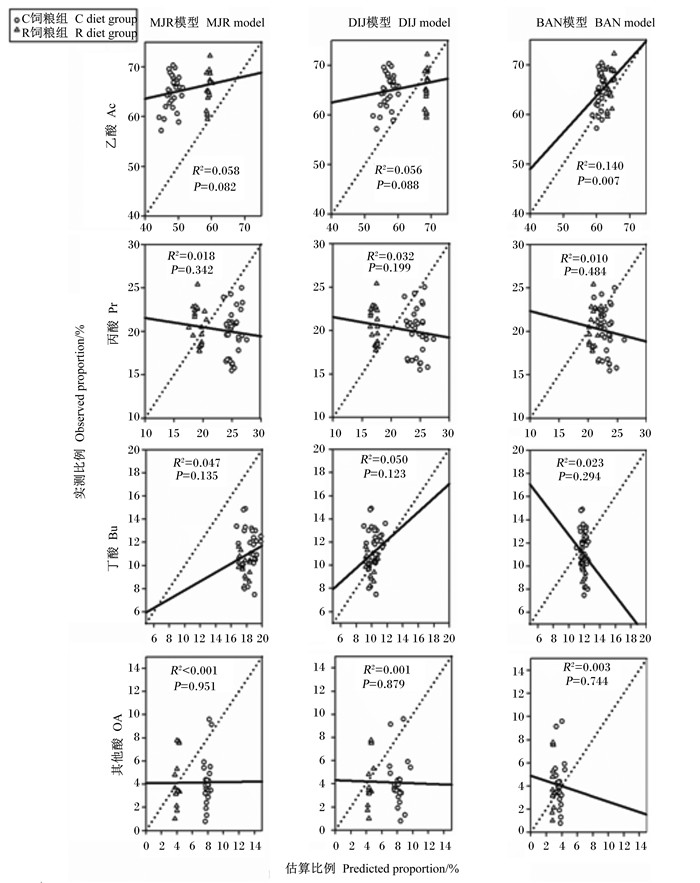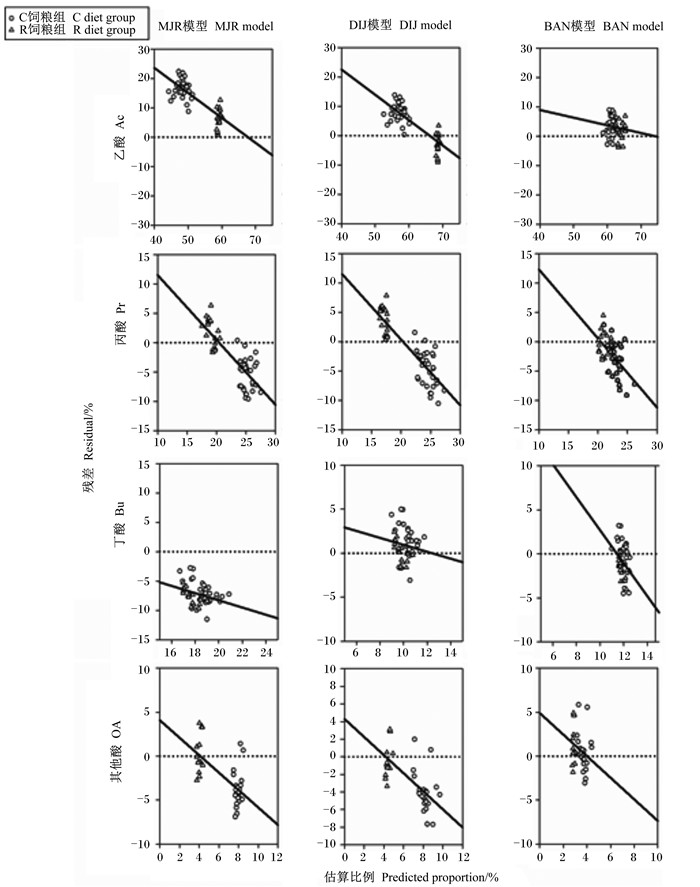2. 湖南农业大学动物科学技术学院, 长沙 410128;
3. 湖南畜禽安全生产协同创新中心, 长沙 410128
2. College of Animal Science and Technology, Hunan Agricultural University, Changsha 410128, China;
3. Hunan Collaborative Innovation Center of Animal Production Safety, Changsha 410128, China
挥发性脂肪酸(volatile fatty acids,VFA)是饲料中碳水化合物经瘤胃微生物发酵的产物,是维持反刍家畜生命和生产的主要能量来源(提供其能量需要量的70%~80%)。VFA包括乙酸、丙酸、丁酸和其他短链脂肪酸,其中乙酸、丙酸和丁酸占瘤胃发酵产生VFA总产量的95%[1]。乙酸和丁酸是脂肪合成的前体物,丙酸是反刍家畜糖异生的前体物[2]。据Brunette等[3]和Seymour等[4]报道,瘤胃内VFA比例影响奶牛的产奶量和乳蛋白与乳脂含量,对维持奶牛正常能量代谢至关重要。
奶牛瘤胃内VFA比例的数学模型包括经验模型和机制模型,其中机制模型也称化学计量学模型。相比经验模型,化学计量学模型包括饲粮各化学组分在瘤胃内的有效降解率和VFA各组分间的转化系数,能更好地反映饲粮各化学组分与瘤胃内VFA组成的关系。因此,国外学者提出了利用饲粮各化学组分预测奶牛瘤胃内VFA比例的模型[5-6]。但是,这些模型估算不同地区和不同年代奶牛瘤胃内VFA比例的精度存在较大差异[7]。目前,利用该模型来估算我国泌乳奶牛瘤胃内VFA比例的研究很少。
1982年,Murphy等[8]第1次利用5类化学组分,通过无限叠代和最小二乘法构建了国际上首个化学计量学模型(简称MUR模型)。1992年,Dijkstra等[9]在MUR模型基础上进一步引入瘤胃内pH和VFA各组分的吸收速率,构建了新的模型(简称DIJ模型)。2006年,Bannink等[10]在DIJ模型基础上引入VFA生成的生化途径,构建了相应的模型(简称BAN模型)。本研究的目的是评估国外经典模型预测我国泌乳奶牛瘤胃内VFA比例的精度,探讨影响模型估算精度的原因。本研究通过检索我国学者发表的研究论文,整理动物体重、干物质采食量、饲粮组分和VFA数据等相关信息,利用预测误差均方(mean squared prediction error,MSPE)和一致性相关系数(consistent correlation coefficient,CCC)2种分析方法评估国际上3个经典模型的估算精度,研究结果将有助于筛选和发展适合预测我国泌乳奶牛瘤胃VFA的化学计量学模型。
1 材料与方法 1.1 模型选择本研究选用了3个经典的反刍家畜瘤胃VFA模型,分别为MUR模型[8]、DIJ模型[9]和BAN模型[10]。按照3个模型所需要的数据要求,把饲粮分为精料组(C饲粮,精料比重≥50%)和粗料组(R饲粮,精料比重<50%)。3个模型需要的共同参数包括:饲粮5大化学组分(可溶性碳水化合物、淀粉、纤维素、半纤维素和粗蛋白质)含量、采食量、5大化学组分瘤胃有效降解率,瘤胃内VFA比例。3个模型均采用无限叠代和最小二乘法建立了5大化学组分(自变量)和VFA比例(因变量)之间的转化系数。
1.2 奶牛试验数据本研究所用中文和英文文章分别通过中国知网和Web of Science搜索。搜索关键词为奶牛、研究团队名称和所在机构名称,论文发表时间为2000—2016年。搜索团队(机构)为谭支良(中国科学院亚热带农业生态研究所)、王加启(中国农业科学院北京畜牧兽医研究所)、刘建新(浙江大学)、刁其玉(中国农业科学院饲料研究所)、李胜利(中国农业大学)、孟庆翔(中国农业大学)、王洪荣(扬州大学)和朱伟云(南京农业大学),检索所获得的中文文章分别有10篇、7篇、5篇、16篇、7篇、12篇、2篇和2篇,检索所获得的英文文章分别有2篇、12篇、32篇、1篇、19篇、2篇、2篇和2篇。在此基础上,仅保留泌乳奶牛饲养试验论文(删除犊牛论文2篇),且论文提供动物饲粮、体重、干物质采食量、饲料添加剂、VFA各组分比例等数据。另外,C饲粮乙酸比例一般不超过70%,乙酸比例大于70%的论文则删除(1篇)。满足这些条件的SCI论文为14篇,中文核心期刊论文为3篇,各团队采用论文分别为谭支良1篇(Wang等[11])、王加启7篇(王吉峰等[12]、Sun等[13]、Yang等[14]、Peng等[15]、Guo等[16]、Pan等[17]和Zhao等[18])、刘建新2篇(Wang等[19]、Zhang等[20])、李胜利6篇(张倩等[21]、曾银等[22]、Guo等[23]、Sun等[24]、Chen等[25]、Cao等[26])和朱伟云1篇(Wang等[27])。另外,数据还增加了1篇谭支良团队未发表论文。
1.3 奶牛饲粮信息我国发表的17篇和未见刊论文1篇中,中文核心期刊根据张丽英[28]描述的方法测定各种营养成分含量,共2篇。13篇英文论文中有机物(OM)、粗蛋白质(CP)、粗灰分(Ash)和粗脂肪(EE)则参考美国分析化学家协会(AOAC)[29-30]测定方法,中性洗涤纤维(NDF)和酸性洗涤纤维(ADF)含量参考Van Soest等[31]方法测定。3篇文章没有报道或者缺失部分饲粮组分信息,则参考《国际反刍动物饲料成分及营养价值表》[32]和《CNCPS体系演变模型及饲料成分表》[33]估算。饲粮可溶性碳水化合物、半纤维素和纤维素通过以下公式[34]计算:
可溶性碳水化合物=OM-EE-淀粉-NDF-CP;
半纤维素=NDF-ADF;
纤维素=ADF-酸性洗涤木质素(ADL)。
1.4 饲粮瘤胃有效降解选择的模型需要提供饲粮5大化学组分的瘤胃有效降解量。饲粮5大化学组分在瘤胃中的有效降解量通过瘤胃流通速率、快速降解部分、慢速降解部分的降解量来计算。计算公式[35]如下:

|
式中:Pt为某化学组分的瘤胃有效降解量(%);a为该化学组分的快速降解部分含量(%);b为该化学组分的慢速降解部分含量(%);c为该化学组分的瘤胃降解速率(h-1);k为该化学组分的瘤胃流通速率(h-1);t为时间(取24 h)。
饲粮各化学组分的瘤胃流通速率参考Fox等[36]建立的模型,计算公式如下:

|
式中:Kpf为粗饲料的流通速率(h-1);Kpc为精饲料的流通速率(h-1);D为干物质采食量(kg/d);BW0.75为代谢体重(kg);F为粗饲料占饲粮的比例(%)。
1.5 模型分析本试验采用MSPE[37]和CCC[38]2种分析方法评估3个模型的预测精度。MSPE分析方法包括整体偏差的偏离(error due to overall bias, ECT)、回归斜率偏离(error due to the regression slope from unity, ER)和随机效应(random error, ED)3部分,以实测值的百分比形式表示。CCC分析方法包括偏差校正因子(Cb),估算值与实测值间的相关系数(r),实测值总体标准差和估算值总体标准差的比值(v),实测值与估算值间的偏移程度(u)4部分组成。2个分析方法使用的计算公式参考谢天宇[39]。奶牛瘤胃VFA各组分实测值与估算值、残差与估算值的相关关系采用SPSS 18.0软件进行线性回归分析,显著性水平为P < 0.01。
2 结果 2.1 奶牛饲粮信息汇总奶牛体重、饲粮、干物质采食量等数据详见表 1。奶牛DMI范围处于10.5~24.0 kg/d,平均值为17.6 kg/d;奶牛体重范围处于474~700 kg,平均值为560 kg。C饲粮组淀粉含量(172~387 g/kg)高于R饲粮组(86~244 g/kg),NDF含量(253~539 g/kg)低于R饲粮组(371~521 g/kg)。
|
|
表 1 奶牛和饲粮组成信息汇总(干物质基础) Table 1 Summary of dairy cow dietary chemical composition (DM basis) |
可溶性碳水化合物、淀粉、纤维素、半纤维素和粗蛋白质在瘤胃有效降解的范围,C饲粮组中分别为0.60~3.13 kg/d、1.37~3.52 kg/d、0.59~2.59 kg/d、0.46~1.42 kg/d和0.33~1.99 kg/d,R饲粮组中分别为0.74~2.73 kg/d、0.96~2.55 kg/d、0.80~1.43 kg/d、0.38~1.16 kg/d和0.66~1.75 kg/d(表 2)。
|
|
表 2 饲粮瘤胃有效降解和VFA比例的数据汇总 Table 2 Summary on the effective degradation of diet in the rumen and the VFA ratio |
瘤胃中实测的挥发性脂肪酸比例如下:乙酸的范围处于57.2%~72.9%,平均值65.5%;丙酸的范围处于15.5%~25.4%,平均值为20.2%;丁酸的范围处于7.5%~13.6%,平均值为11.0%;其他酸(包括戊酸、异戊酸和异丁酸)的范围处于0.8%~9.6%,平均值为4.1%(表 2)。
2.4 MSPE分析法结果由表 3和图 1可知,BAN模型乙酸比例RMSPE最小(6.8%),决定系数(R2)最大(0.140);MUR模型RMSPE最大(21.6%)。BAN模型估算值与实测值的一次回归线与1 : 1标准线最为接近,偏差来自整体偏差的偏离(47.8%)。3个模型预测丙酸、丁酸和其他酸比例的R2均小于0.100,无显著相关性(P>0.01)。
|
|
表 3 MSPE分析法结果汇总 Table 3 Summary of MSPE analysis |

|
实线:奶牛瘤胃内VFA比例估算值与实测值间的一次回归线;虚线:1 : 11标准线。
Solid line: The regression line between predicted and observed VFA proportions in rumen of dairy cows; dashed line: 1 : 1 standard line. 图 1 奶牛瘤胃内VFA比例估算值与实测值间的关系 Figure 1 Relationship between predicted and observed VFA proportions in rumen of dairy cows |
残差与估算值之间的一次回归分析结果见表 4。MUR模型、DIJ模型乙酸、丙酸和其他酸及BAN模型丙酸预测残差与估算值线性回归的斜率、截距与0比较差异显著(P < 0.01);模型的预测残差与估算值线性回归的决定系数R2的范围分布在0.019~0.749。
|
|
表 4 预测残差与估算值间的线性关系 Table 4 The linear relationship between the predicted residuals and values |
由表 5和图 2可知,BAN模型乙酸比例CCC值最大(0.178),MUR模型最小(0.044),BAN模型残差与估算值回归方程与0标准线最为接近。丙酸、丁酸和其他酸比例预测值与实测值的残差分析结果显示:模型CCC值均小于0.120,残差与估算值回归方程与0标准线有明显的交叉。3个模型预测丙酸的Cb值均大于0.200,u值均小于0,说明丙酸比例被高估。
|
|
表 5 CCC分析结果汇总 Table 5 Summary of CCC analysis results |

|
实线:奶牛瘤胃内VFA比例残差(实测值-估算值)与估算值间的一次回归线;虚线:0标准线。
Solid line: The regression line between residual (observed value-predicted) and predicted VFA proportions in rumen of dairy cows; dashed line: 0 standard line. 图 2 奶牛瘤胃内VFA比例残差与估算值间的关系 Figure 2 Relationship between residual and predicted VFA in rumen of dairy cattle |
Alemu等[40]利用141组奶牛数据评估了4个VFA模型,结果显示:MUR模型的估算精度偏低。这与本试验结果一致。本研究中,MUR模型R2均低于0.1,无显著相关性。MSPE组分分析结果说明,乙酸、丙酸、丁酸和其他酸的整体偏差和斜率误差超过了模型估算误差的50%。残差与估算值回归方程与0标准线有明显的交叉,且乙酸、丙酸和其他酸残差与估算值回归方程的斜率和截距差异显著。MUR模型没有考虑VFA各组分的生成速率、相互转化和吸收利用量[41]。另外,MUR模型利用肉牛和羊VFA数据构建各化学组分与VFA各组分的转化系数。Chamberlain等[42]和Loncke等[43]比较肉牛和羊瘤胃内VFA组成的结果显示,肉牛瘤胃乙酸与丙酸的比例高于羊。Morvay等[44]利用101组奶牛数据评估了6个VFA模型,结果发现MUR模型的估算精度较低,认为利用肉牛和羊2种反刍家畜实测VFA数据所获取的模型不能很好地用于估算奶牛瘤胃VFA组成。因此,本研究中MUR模型估算精度较低的原因有2个:1)MUR模型没有考虑VFA各组分的生成速率、相互转化和吸收利用量[36];2)利用肉牛和羊数据建立的模型转化系数可能不适合奶牛[44]。
Dijkstra等[9]认为反刍家畜瘤胃产生的一部分VFA被瘤胃壁吸收利用,因此,DIJ模型引入了Hogan[45]和Danielli等[46]报道的乙酸、丙酸、丁酸、以及其他VFA的吸收速率。另外,DIJ模型还引入了瘤胃内pH因子,因为瘤胃内pH也是影响VFA生成的重要因子[44]。本研究CCC分析结果显示,DIJ模型的估算精度偏低(均低于0.160),且R2均低于0.100,无显著相关性。残差与估算值回归方程与0标准线有明显的交叉,且乙酸、丙酸和其他酸比例残差与估算值回归方程的斜率和截距差异显著。另外,R饲粮与C饲粮的乙酸、丙酸和其他酸预测值与实测值间差异出现明显分层。Bannink等[47]利用奶牛数据评估3种模型时,认为DIJ模型的估算精度偏低,并且R饲粮与C饲粮的VFA比例预测值与实测值间差异也出现明显分层。造成DIJ模型预测精度很低的原因可能是:1)模型仅考虑到了VFA的吸收速率,没有考虑到VFA之间的相互转化和产生速率[43];2)模型没有考虑到微生物发酵的生化途径对VFA比例的影响[48]。
BAN模型引入己糖降解生成VFA各组分的生化途径。例如,1 mol碳水化合物(可溶性碳水化合物、淀粉、纤维素、半纤维素)的己糖单位降解可生成2 mol乙酸和丙酸、1 mol丁酸和其他酸,而1 mol蛋白质等效于0.55 mol碳水化合物的己糖[48]。因此,BAN模型5大化学组分转化为乙酸和丙酸的模型方程在原来的基础上乘以2。此外,BAN模型还引入了VFA的吸收和流通速率等因子。BAN模型细化瘤胃己糖降解的生物化学过程,进一步提高了模型对VFA各组分比例的估算精度。Morvay等[44]研究结果发现,相比MUR模型和DIJ模型,BAN模型提高了乙酸的估算精度,这与本研究结果一致。本研究中,乙酸比例预测值与实测值回归方程差异显著,且MSPE和CCC分析法均说明,BAN模型乙酸的估算精度是3个模型中最高的。
BAN模型虽然提高了乙酸的估算精度,但是该模型预测乙酸的精度仍偏低(CCC值小于0.200),R2小于0.200。MSPE组分分析结果说明,乙酸整体偏差和斜率误差超过了模型估算误差的45%。相关研究已证实瘤胃VFA的比例受饲粮中化学组分的影响[49]。本研究C饲粮组和R饲粮组淀粉摄入量低于BAN模型中的淀粉摄入量;C饲粮组和R饲粮组中NDF含量平均值高于BAN模型中的NDF含量,说明我们国家奶牛饲粮淀粉和NDF含量分别低于和高于BAN模型建立时所使用的奶牛饲粮。与荷兰相比,我国奶牛饲养水平整体相对偏低[50-51]。此外,BAN模型建立时假定了VFA各组分的吸收和流通速率相同。Murphy[52]报道,瘤胃VFA的吸收速率会随着VFA链的长度增加而变大,这种假设也会增加乙酸的比例,从而影响模型的估算精度。
4 结论① 尽管BAN模型估算乙酸比例的精度是最高的,但其估算的乙酸比例的精度仍然偏低,且误差主要来源于整体偏差的偏离。
② MUR模型、DIJ模型、BAN模型无法预测丙酸、丁酸和其他酸的比例。
③ MUR模型、DIJ模型、BAN模型建立时所使用的数据全部来自国外养殖牧场,不适合用于估算我国奶牛瘤胃VFA组成,迫切需要利用更多数据建立适合我国国情的VFA化学计量学预测模型。
| [1] |
BERGMAN E N. Energy contributions of volatile fatty acids from the gastrointestinal tractin various species[J]. Physiological Reviews, 1990, 70(70): 567-590. |
| [2] |
MCLEOD K R, BALDWIN R L. Effects of diet forage:concentrate ratio and metabolizable energy intake on visceral organ growth and in vitro oxidative capacity of gut tissues in sheep[J]. Journal of Animal Science, 2000, 78(3): 760-770. DOI:10.2527/2000.783760x |
| [3] |
BRUNETTE T, BAURHOO B, MUSTAFA A F, et al. Effects of replacing grass silage with forage pearl millet silage on milk yield, nutrient digestion, and ruminal fermentation of lactating dairy cows[J]. Journal of Dairy Science, 2016, 99(1): 269-279. DOI:10.3168/jds.2015-9619 |
| [4] |
SEYMOUR W M, CAMPBELL D R, JOHNSON Z B. Relationships between rumen volatile fatty acid concentrations and milk production in dairy cows:a literature study[J]. Animal Feed Science & Technology, 2005, 119(1/2): 155-169. |
| [5] |
FRIGGENS N C, OLDHAM J D, DEWHURST R J, et al. Proportions of volatile fatty acids in relation to the chemical composition of feeds based on grass silage[J]. Journal of Dairy Science, 1998, 81(5): 1331-1344. DOI:10.3168/jds.S0022-0302(98)75696-6 |
| [6] |
ARGYLE J L, BALDWIN R L. Modeling of rumen water kinetics and effects of rumen pH Changes[J]. Journal of Dairy Science, 1988, 71(5): 1178-1188. DOI:10.3168/jds.S0022-0302(88)79672-1 |
| [7] |
NOZIÈRE P, ORTIGUES-MARTY I, LONCKE C, et al. Carbohydrate quantitative digestion and absorption in ruminants:from feed starch and fibre to nutrients available for tissues[J]. Animal, 2010, 4(7): 1057-1174. DOI:10.1017/S1751731110000844 |
| [8] |
MURPHY M R, BALDWIN R L, KOONG L J. Estimation of stoichiometric parameters for rumen fermentation of roughage and concentrate diets[J]. Journal of Animal Science, 1982, 55(2): 411-421. DOI:10.2527/jas1982.552411x |
| [9] |
DIJKSTRA J, NEAL H D, BEEVER D E, et al. Simulation of nutrient digestion, absorption and outflow in the rumen:model description[J]. The Journal of Nutrition, 1992, 122(11): 2239-2256. DOI:10.1093/jn/122.11.2239 |
| [10] |
BANNINK A, KOGUT J, DIJKSTRA J, et al. Estimation of the stoichiometry of volatile fatty acid production in the rumen of lactating cows[J]. Journal of Theoretical Biology, 2006, 238(1): 36-51. DOI:10.1016/j.jtbi.2005.05.026 |
| [11] |
WANG M, WANG R, XIE T Y, et al. Shifts in rumen fermentation and Microbiota are associated with dissolved ruminal hydrogen concentrations in lactating dairy cows fed different types of carbohydrates[J]. The Journal of Nutrition, 2016, 146(9): 1714-1721. DOI:10.3945/jn.116.232462 |
| [12] |
王吉峰, 王加启, 李树聪, 等. 不同日粮对奶牛瘤胃发酵模式及泌乳性能的影响[J]. 畜牧兽医学报, 2005, 36(6): 569-573. |
| [13] |
SUN P, WANG J Q, DENG L F. Effects of Bacillus subtilis natto on milk production, rumen fermentation and ruminal microbiome of dairy cows[J]. Animal, 2013, 7(2): 216-222. DOI:10.1017/S1751731112001188 |
| [14] |
YANG S L, BU D P, WANG J Q, et al. Soybean oil and linseed oil supplementation affect profiles of ruminal microorganisms in dairy cows[J]. Animal, 2009, 3(11): 1562-1569. DOI:10.1017/S1751731109990462 |
| [15] |
PENG H, WANG J Q, KANG H Y, et al. Effect of feeding Bacillus subtilis natto fermentation product on milk production and composition, blood metabolites and rumen fermentation in early lactation dairy cows[J]. Journal of Animal Physiology and Animal Nutrition, 2012, 96(10): 506-512. |
| [16] |
GUO T J, WANG J Q, BU D P, et al. Evaluation of the microbial population in ruminal fluid using real time PCR in steers treated with virginiamycin[J]. Czech Journal of Animal Science, 2010, 55(7): 276-285. DOI:10.17221/CJAS |
| [17] |
PAN L, BU D P, WANG J Q, et al. Effects of Radix Bupleuri extract supplementation on lactation performance and rumen fermentation in heat-stressed lactating Holstein cows[J]. Animal Feed Science and Technology, 2014, 187: 1-8. DOI:10.1016/j.anifeedsci.2013.09.008 |
| [18] |
ZHAO M, BU D P, WANG J Q, et al. Milk production and composition responds to dietary neutral detergent fiber and starch ratio in dairy cows[J]. Animal Science Journal, 2015, 87(6): 756-766. |
| [19] |
WANG B, MAO S Y, YANG H J, et al. Effects of alfalfa and cereal straw as a forage source on nutrient digestibility and lactation performance in lactating dairy cows[J]. Journal of Dairy Science, 2014, 98(1): 7706-7715. |
| [20] |
ZHANG R Y, ZHU W Y, ZHU W, et al. Effect of dietary forage sources on rumen microbiota, rumen fermentation and biogenic amines in dairy cows[J]. Journal of the Science of Food and Agriculture, 2014, 94(9): 1886-1895. DOI:10.1002/jsfa.6508 |
| [21] |
张倩, 夏建民, 李胜利, 等. 不同比例压块秸秆与羊草组成粗饲料对奶牛瘤胃发酵和生产性能的影响[J]. 动物营养学报, 2010, 22(2): 474-480. |
| [22] |
曾银, 贺鸣, 曹志军, 等. 全混合日粮中粗饲料长度对奶牛咀嚼行为和瘤胃发酵的影响[J]. 动物营养学报, 2010, 22(6): 1571-1578. |
| [23] |
GUO Y Q, ZOU Y, CAO Z J, et al. Evaluation of coarsely ground wheat as a replacement for ground corn in the diets of lactating dairy cows[J]. Asian-Australasian Journal of Animal Sciences, 2014, 26(7): 961-970. |
| [24] |
SUN T, YU X, LI S L, et al. Responses of dairy cows to supplemental highly digestible rumen undegradable protein and rumen-protected forms of methionine[J]. Asian-Australasian Journal of Animal Sciences, 2009, 22(5): 659-666. DOI:10.5713/ajas.2009.80491 |
| [25] |
CHEN P, JI P, LI S L. Effects of feeding extruded soybean, ground canola seed and whole cottonseed on ruminal fermentation, performance and milk fatty acid profile in early lactation dairy cows[J]. Asian-Australasian Journal of Animal Sciences, 2008, 21(2): 204-213. DOI:10.5713/ajas.2008.70079 |
| [26] |
CAO Z J, LI S L, XING J J, et al. Effects of maize grain and lucerne particle size on ruminal fermentation, digestibility and performance of cows in midlactation[J]. Journal of Animal Physiology and Animal Nutrition, 2008, 92(2): 157-167. DOI:10.1111/j.1439-0396.2007.00721.x |
| [27] |
WANG D S, ZHANG R Y, ZHU W Y, et al. Effects of subacute ruminal acidosis challenges on fermentation and biogenic amines in the rumen of dairy cows[J]. Livestock Science, 2013, 155(2/3): 262-272. |
| [28] |
张丽英. 饲料分析及饲料质量检测技术[M]. 3版. 北京: 中国农大出版社, 2007.
|
| [29] |
AOAC. Official methods of analysis[S]. 15th ed. Arlington, V. A. : Association of Official Analytical Chemists, 1990.
|
| [30] |
AOAC. Official methods of analysis[S]. 16th ed. Gaithersburg, M. D. : Association of Official Analytical Chemists, 1997.
|
| [31] |
VAN SOEST P J, ROBERTSON J B, LEWIS B A. Methods for dietary fiber, neutral detergent fiber, and nonstarch polysaccharides in relation to animal nutrition[J]. Journal of Dairy Science, 1991, 74(10): 3583-3597. DOI:10.3168/jds.S0022-0302(91)78551-2 |
| [32] |
熊本海. 国际反刍动物饲料成分及营养价值表[M]. 北京: 中国农业科学技术出版社, 2013.
|
| [33] |
熊本海, 蒋林树. CNCPS体系演变模型及饲料成分表[M]. 北京: 中国农业科学技术出版社, 2015.
|
| [34] |
BENCHAAR C, RIVEST J, POMAR C, et al. Prediction of methane production from dairy cows using existing mechanistic models and regression equations[J]. Journal of Animal Science, 1998, 76(2): 617-627. DOI:10.2527/1998.762617x |
| [35] |
ØRSKOVE R, MCDONALDI. The estimation of protein degradability in the rumen from incubation measurements weighted according to rate of passage[J]. Journal of Agricultural Science, 1979, 92(2): 499-503. |
| [36] |
FOX D G, TEDESCHI L O, TYLUTKI T P, et al. The Cornell net carbohydrate and protein system model for evaluating herd nutrition and nutrient excretion[J]. Animal Feed Science and Technology, 2004, 112. |
| [37] |
WANG M, TANG S X, TAN Z L. Modeling in vitro gas production kinetics:Derivation of Logistic-Exponential (LE) equations and comparison of models[J]. Animal Feed Science and Technology, 2011, 165(3/4): 137-150. |
| [38] |
LIN L I K. A concordance correlation coefficient to evaluate reproducibility[J]. Biometrics, 1989, 45(1): 255-268. DOI:10.2307/2532051 |
| [39] |
谢天宇, 王敏, 王荣, 等. 奶牛胃肠道甲烷排放模型估算精度的评估分析[J]. 畜牧兽医学报, 2015, 46(9): 1574-1583. |
| [40] |
ALEMU A W, DIJKSTRA J, BANNINK A, et al. Rumen stoichiometric models and their contribution and challenges in predicting enteric methane production[J]. Animal Feed Science and Technology, 2011, 166-167: 761-778. DOI:10.1016/j.anifeedsci.2011.04.054 |
| [41] |
BANNINK A, FRANCE J, LOPEZ S, et al. Modelling the implications of feeding strategy on rumen fermentation and functioning of the rumen wall[J]. Animal Feed Science & Technology, 2008, 143(1/2/3/4): 3-26. |
| [42] |
CHAMBERLAIN D G, THOMAS P C, ANDERSON F J. Volatile fatty acid proportions and lactic acid metabolism in the rumen in sheep and cattle receiving silage diets[J]. The Journal of Agricultural Science, 1983, 101(1): 47-58. DOI:10.1017/S0021859600036352 |
| [43] |
LONCKE C, ORTIGUES-MARTY I, VERNET J, et al. Empirical prediction of net portal appearance of volatile fatty acids, glucose, and their secondary metabolites (beta-hydroxybutyrate, lactate) from dietary characteristics in ruminants:a meta-analysis approach[J]. Journal of Animal Science, 2009, 87(1): 253-268. DOI:10.2527/jas.2008-0939 |
| [44] |
MORVAY Y, BANNINK A, FRANCE J, et al. Evaluation of models to predict the stoichiometry of volatile fatty acid profiles in rumen fluid of lactating Holstein cows[J]. Journal of Dairy Science, 2011, 94(6): 3063-3080. DOI:10.3168/jds.2010-3995 |
| [45] |
HOGAN J P. The absorption of ammonia through the rumen of the sheep[J]. Australian Journal of Biological Sciences, 1961, 14(3): 448-460. |
| [46] |
DANIELLI J F, HITCHCOCK M W. The mechanism of absorption from the rumen as exemplified by the behaviour of acetic, propionic and butyric acids[J]. Journal of Experimental Biology, 1945, 22: 75-84. |
| [47] |
BANNINK A, DE VISSER H, VAN VUUREN A M. Comparison and evaluation of mechanistic rumen models[J]. British Journal of Nutrition, 1997, 78(4): 563-581. DOI:10.1079/BJN19970175 |
| [48] |
BALDWIN R L, DONOVAN K C. Modeling ruminant digestion and metabolism[C]//CLIFFORD A J, MVLLER H G. Advances in Experimental Medicine & Biology. Boston, M. A. : Springer, 1995, 445: 325-345.
|
| [49] |
王荣, 杨玲媛, 王敏, 等. 基于挥发性脂肪酸化学计量模型体外预测山羊瘤胃甲烷产量的精度[J]. 应用生态学报, 2014, 25(5): 1518-1524. |
| [50] |
ELGERSMA A, TAMMINGA S, ELLEN G. Modifying milk composition through forage[J]. Animal Feed Science and Technology, 2006, 131(3/4): 207-225. |
| [51] |
LIU S W, ZHANG R H, KANG R, et al. Milk fatty acids profiles and milk production from dairy cows fed different forage quality diets[J]. Animal Nutrition, 2016, 2(4): 329-333. DOI:10.1016/j.aninu.2016.08.008 |
| [52] |
MURPHY M R. Modeling production of volatile fatty acids in ruminants[C]//Modeling Ruminant Digestion and Metabolism, Proceedings of the 2nd International Workshop. Davis: University of California, 1984.
|




